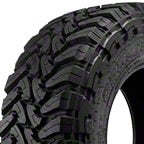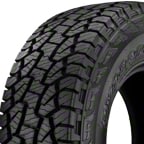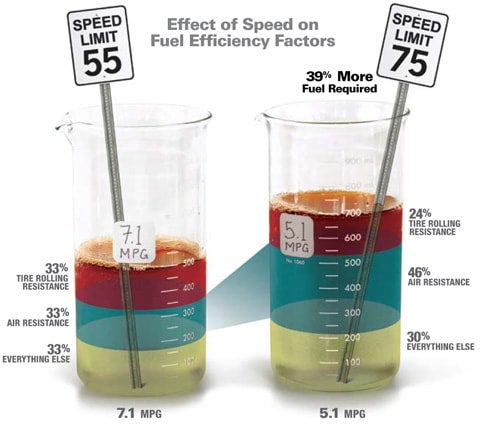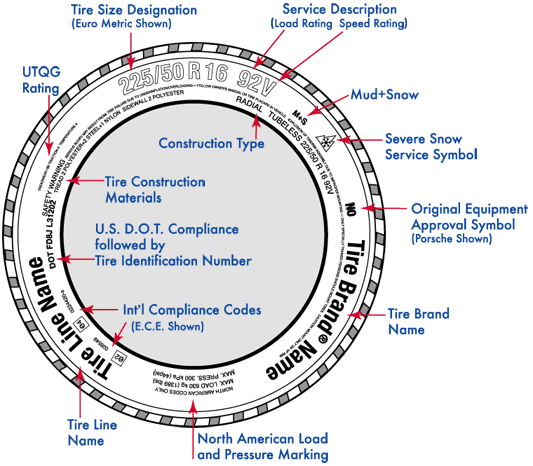Oversized Tires
Oversized Tires

Toyo Open Country M/T
Designed to help full-sized pickups work hard on pavement, then work just as hard when roads are muddy, snowy, and rocky-or when there are no roads at all. The Open Country M/T combines solid on-road performance with extra ground clearance, higher load-carrying capacity, and greater ability to go off-road. Truck enthusiasts know it for its long wear, low noise and aggressive tread pattern.

Open Country R/T
Off-road performance meets on-road comfort with the all-new Open Country R/T. Built rugged for any terrain, this tire offers excellent off-road traction, durable construction and aggressive styling. Its ability to tackle dirt, sand and rocks is inspired by the legendary Open Country M/T, while its quieter ride is a nod to our best-selling Open Country A/T II. These tires are 100% American-made at the state-of-the-art Toyo Tires factory in Georgia.

Hankook Dynapro ATM
The Hankook Dynapro ATM -Premium aggressive all-terrain for light truck, van & sport utility vehicle. Innovative tread and sidewall design to enhance the style of your vehicle. Developed for high powered pickups. The Dynapro ATm offers the best grip and acceleration both on- and off-road.

Hankook Dynapro MT
Off-road driving excitement. Dynapro MT boasts superb multi-directional traction and excellent grip, acceleration and anti-puncture capability. Even under harsh off-road conditions, expect the best possible driving performance with excellent handling and stability on any road type
Tire Facts: Brief Facts About Tires
It's no secret that buying tires would be much easier with a solid understanding of tires. That's probably why you're on a page called "Tire Facts." Information that will help with your purchase includes how they're manufactured, which are right for specific vehicles, and how to understand the complex tire codes that are listed on the side of the tire. Simple tire facts will also help you to maintain your tires once they are on a vehicle, allowing for optimal wear, performance, and vehicle safety. The following facts will improve your understanding of tires and guide your purchasing decision.
Tire Components Tires are made of several different components, including the tread, sidewall, and tire plies, to name a few. The precise combination of variations of these components allows for the construction of tires that are particularly good in certain conditions, certain kinds of driving, and certain kinds of vehicles.

Tire Tread
Each tire has a tread pattern, which is the part of the tire that comes into contact with the driving surface as the tire rolls. The area that is actually touching the road at any given moment is known as the contact patch. Treads are made up of tread blocks, which can vary in size, shape, look, and function. Additionally, the tread pattern is made up of the area known as the tread void, which consists of the grooves between the tread blocks and allow the tread blocks to remain flexible. Tread grooves also remove water out from under the tire as it rolls. Some tread patterns possess rain grooves, which are often deeper than the tread void and are designed to enhance water evacuation from between the contact patch and road surface.
Tires contain what is known as a wear bar. The wear bar serves as a built-in warning system to alert you when the tire needs to be replaced. This small raised feature within the tread void or groove is easy to see upon visual inspection.
Tire Sidewall
The sidewall is the side of the tire that's easily seen when a tire is mounted on a vehicle. It has a great deal of information on it including the manufacturer's name, the size of the tire, the maximum inflation, etc.
The tire bead is the part of the tire that holds it securely onto the rim. It is constructed of a durable rubber compound that's reinforced with a small steel cable. Keeping your tire properly inflated is crucial for ensuring that the tire bead keeps a strong seal between the tire and the rim.
Tire Shoulder
The tire shoulder is the area of the tire where the sidewall and the tread meet.
Tire Ply
Layers of various materials, including fabrics, plastics, metals, and rubber are laid inside the tire to help it maintain its shape throughout the wear and tear it experiences with pressure from the air inside and the road outside. Each layer is known as a tire ply.
Tire Specs
Most tire specifications can be found on the sidewall of the tire. They are included in the series of letters and numbers sometimes referred to as the tire code. The specifications included in the tire code are the tire size, whether or not the tire has radial construction, the type of vehicle the tire was manufactured for, and may also include the speed rating. You'll also find inflation information on the sidewall of the tire, including maximum PSI that a tire is capable of. Tire specifications also include the load rating, which is important for vehicles that will be used for hauling or towing. The optimal inflation level and load rating can be found in your vehicle owner's manual.
Tire Sizes
When many people begin shopping for tires, they have a certain look in mind for the type of tires they'd like to see on their vehicle or a specific tire that they've had good experience with. While you may want a certain look or a certain tire, you may not find one that fits your vehicle. It's absolutely necessary to use the manufacturer-recommended tire size in order for your vehicle to perform safely. In fact, automaker-certified technicians like those employed by dealership won't install any tires on your vehicle that aren't the perfect size. And these technicians know your vehicle best.
As mentioned before, the size of the tire is listed in the tire code. The code can be read as follows: the first three digits are the width of the tire in millimeters. This measurement is followed by a slash and then a two digit number. That two digit number is the height of the sidewall as a percentage of the tire's width. For example, if the tire code starts like this: 205/55, then the height of the sidewall is 55% of 205, or 110 millimeters. If an "R" appears after the sidewall height, that means the tire has radial construction. The next two digits are the diameter of the rim the tire fits on. The next number is the code that indicates the maximum load capacity of the tire. Finally, if there is a letter at the end of the code, it is the tire's speed rating. Here is an example of a tire code: 205/55R16 88V






